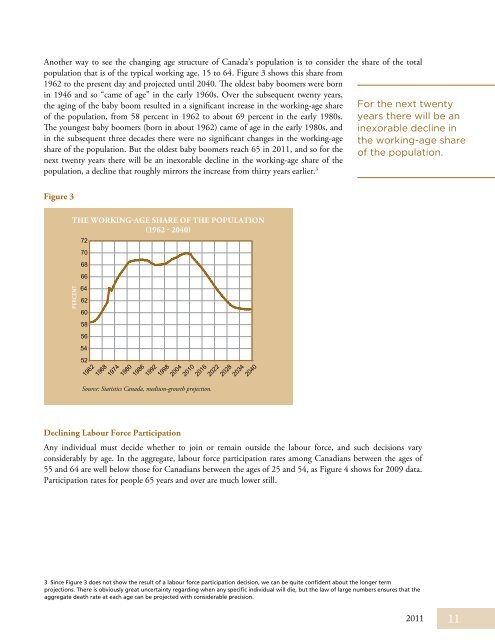Christopher Ragan, "Canada's Looming Fiscal Squeeze," November
Christopher Ragan, "Canada's Looming Fiscal Squeeze," November
Christopher Ragan, "Canada's Looming Fiscal Squeeze," November
Create successful ePaper yourself
Turn your PDF publications into a flip-book with our unique Google optimized e-Paper software.
Another way to see the changing age structure of Canada’s population is to consider the share of the total<br />
population that is of the typical working age, 15 to 64. Figure 3 shows this share from<br />
1962 to the present day and projected until 2040. The oldest baby boomers were born<br />
in 1946 and so “came of age” in the early 1960s. over the subsequent twenty years,<br />
the aging of the baby boom resulted in a significant increase in the working-age share<br />
of the population, from 58 percent in 1962 to about 69 percent in the early 1980s.<br />
The youngest baby boomers (born in about 1962) came of age in the early 1980s, and<br />
in the subsequent three decades there were no significant changes in the working-age<br />
share of the population. but the oldest baby boomers reach 65 in 2011, and so for the<br />
next twenty years there will be an inexorable decline in the working-age share of the<br />
population, a decline that roughly mirrors the increase from thirty years earlier. 3<br />
Figure 3<br />
THE WoRKING-AGE SHARE oF THE PoPuLATIoN<br />
(1962 - 2040)<br />
PERCENT<br />
72<br />
70<br />
68<br />
66<br />
64<br />
62<br />
60<br />
58<br />
56<br />
54<br />
52<br />
1962<br />
Source: Statistics Canada, medium-growth projection.<br />
Declining Labour Force Participation<br />
1968<br />
1974<br />
1980<br />
1986<br />
1992<br />
1998<br />
2004<br />
2010<br />
2016<br />
2022<br />
2028<br />
2034<br />
2040<br />
For the next twenty<br />
years there will be an<br />
inexorable decline in<br />
the working-age share<br />
of the population.<br />
Any individual must decide whether to join or remain outside the labour force, and such decisions vary<br />
considerably by age. In the aggregate, labour force participation rates among Canadians between the ages of<br />
55 and 64 are well below those for Canadians between the ages of 25 and 54, as Figure 4 shows for 2009 data.<br />
Participation rates for people 65 years and over are much lower still.<br />
3 Since Figure 3 does not show the result of a labour force participation decision, we can be quite confident about the longer term<br />
projections. There is obviously great uncertainty regarding when any specific individual will die, but the law of large numbers ensures that the<br />
aggregate death rate at each age can be projected with considerable precision.<br />
2011<br />
11





